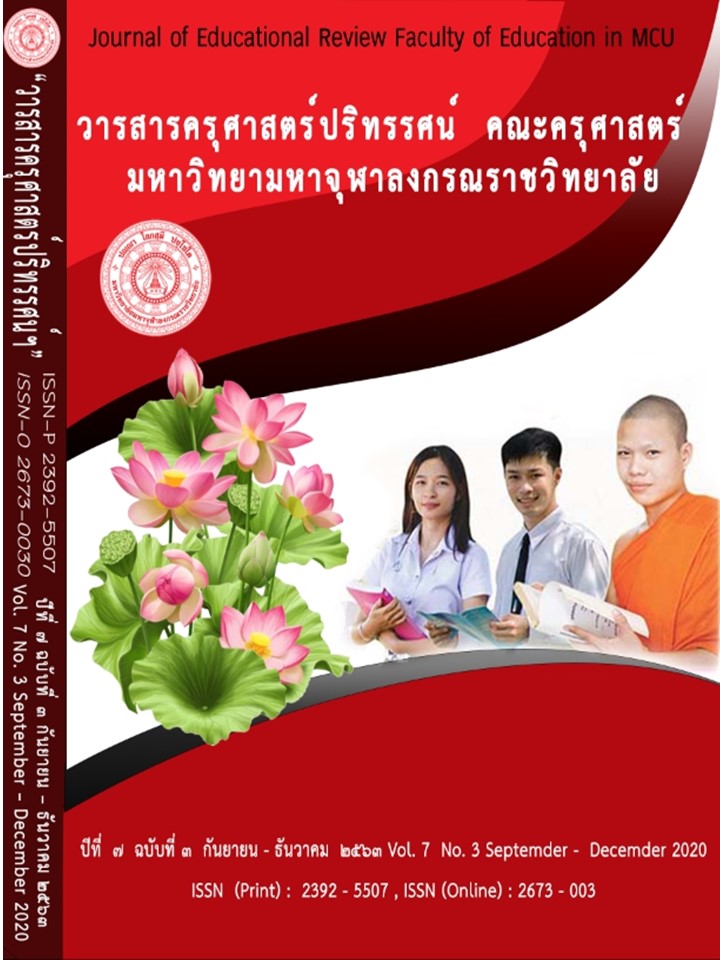A MODEL OF SUSTAINABLE ENVIRONMENTAL ADMINISTRATION DEVELOPMENT BASED ON SAPPAYA DHAMMA PRIMARY SCHOOLS UNDER BANGKOK METROPOLITAN ADMINISTRATION
Main Article Content
Abstract
The objective of this research paper was to propose a model of sustainable environmental administration development based on Sappaya Dhamma for primary schools under Bangkok Metropolitan Administration. Mixed methods research was conducted and three steps were designed. Step 1: Study of environmental management conditions in primary schools under Bangkok Metropolitan Administration. The questionnaire was used for collecting 390 administrators and teachers. Data were analyzed by descriptive statistics consisted of frequency, percentage, mean and standard deviation. Step 2: the model was developed by interviewing 24 key informants, and the data was analyzed by content analysis. Step 3: proposing a model by focus group discussion with 9 experts using focus group discussion guidelines, and data was analyzed by content analysis. The results of the research were found that 1) a model of sustainable environmental administration development based on Sappaya Dhamma for primary schools under Bangkok Metropolitan Administration consisted of 4 elements: 1) Principle, 2) Purpose, 3) Method of Action, and 4) Process. The environmental management in primary schools covered all 3 aspects which were (1) the social environment within the school that arranged the environment of material, buildings and educational institutions, (2) social environment within the school which were policies, planning, supervision, evaluation of culture, traditions, rules and regulations related to environment in educational institutions, and (3) teaching and learning management that was the management of learning, creativity, development activities and reporting of performance to support environmental performance by developing environmental management in accordance with sustainable Sappaya Dhamma which was suitable thing that supports helping the administration to be effective, including (1) suitable residences, (2) appropriate travel, (3) proper communication, (4) suitable person, (5) appropriate food, (6) appropriate weather, and (7) appropriate performance.
Article Details
ทัศนะและความคิดเห็นที่ปรากฏในบทความในวารสารฉบับนี้ถือเป็นความรับผิดชอบของผู้เขียนบทความนั้นเพียงผู้เดียว และไม่ถือเป็นทัศนะและความรับผิดชอบของกองบรรณาธิการ
กองบรรณาธิการขอสงวนสิทธิ์ในการคัดเลือกบทความลงตีพิมพ์และจะแจ้งให้เจ้าของบทความทราบหลังจากผู้ประเมินบทความตรวจอ่านบทความแล้ว
ต้นฉบับที่ได้รับการตีพิมพ์ในวารสารครุศาสตร์ปริทรรศน์ คณะครุศาสตร์ มหาวิทยาลัยมหาจุฬาลงกรณราชวิทยาลัย ถือเป็นกรรมสิทธิ์ของคณะครุศาสตร์ มหาวิทยาลัยมหาจุฬาลงกรณราชวิทยาลัย ห้ามนำข้อความทั้งหมดหรือบางส่วนไปพิมพ์ซ้ำ เว้นเสียแต่ว่าจะได้รับอนุญาตจากมหาวิทยาลัยฯ เป็นลายลักษณ์อักษร
References
จันทรานี สงวนนาม. (2551). ทฤษฎีและแนวปฏิบัติในการบริหารสถานศึกษา. พิมพ์ครั้งที่ 2. กรุงเทพมหานคร: บ๊คพ้อยท์.
ธเนศ ขำเกิด. (2551). การจัดบรรยากาศและสิ่งแวดล้อมที่ดีในองค์กร. ชลบุรี: มหาวิทยาลัยบูรพา.
ธานินทร์ ศิลป์จารุ. (2552). การวิจัยและวิเคราะห์ข้อมูลทางสถิติด้วย SPSS. พิมพ์ครั้งที่ 10. กรุงเทพมหานคร: บิสซิเนสอาร์แอนด์ดี.
นงนภัส คู่วรัญญู เที่ยงกมล. (2551). สิ่งแวดล้อมและการพัฒนา เล่ม 1. กรุงเทพมหานคร: จุฬาลงกรณ์มหาวิทยาลัย.
นินาท พลเดช. (2558). รูปแบบการบริหารสิ่งแวดล้อมที่ส่งเสริมการจัดการเรียนรู้ในสถานศึกษาขั้นพื้นฐาน. ดุษฎีนิพนธ์ครุศาสตรดุษฎีบัณฑิต. มหาวิทยาลัยราชภัฏอุบลราชธานี.
พระพรหมคุณาภรณ์ (ป. อ. ปยุตโต). (2551). พจนานุกรมพุทธศาสตร์ ฉบับประมวลธรรม. พิมพ์ครั้งที่ 16. กรุงเทพมหานคร: เอส. อาร์. พริ้นติ้งแมสโปรดักส์.
มหาวิทยาลัยจุฬาลงกรณราชวิทยาลัย. (2539). พระไตรปิฎกฉบับภาษาไทย ฉบับจุฬาลงกรณราชวิทยาลัย. กรุงเทพมหานคร: โรงพิมพ์มหาจุฬาลงกรณราชวิทยาลัย.
ระพี สาคริก. (2552). การศึกษากับการจัดการ. กรุงเทพมหานคร: วศิระ.
สุทธิพงศ์ นิพัทธนานนท์. (2556). แนวทางในการพัฒนาโรงเรียนสิ่งแวดล้อมศึกษาเพื่อการพัฒนาอย่างยั่งยืนตามกรอบของกรมส่งเสริมคุณภาพสิ่งแวดล้อม. ดุษฎีนิพนธ์ปรัชญาดุษฎีบัณฑิต. มหาวิทยาลัยราชภัฏเชียงใหม่.

